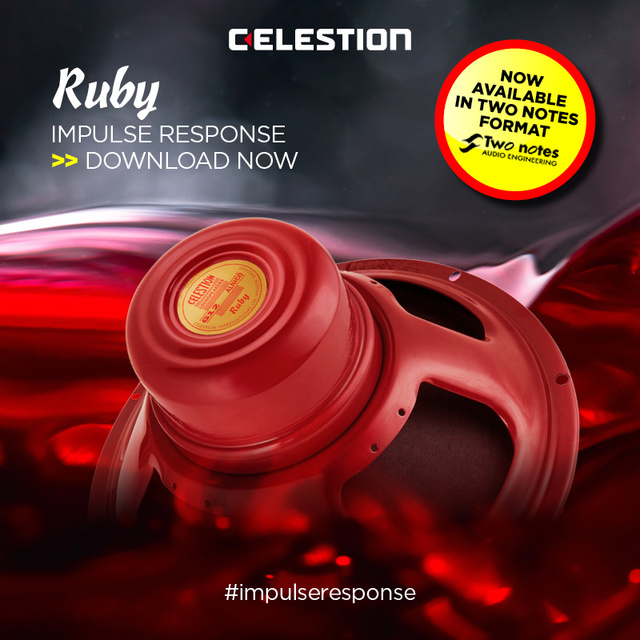
Ipswich, UK (March 24, 2020) —Celestion is delighted to announce the availability of their Celestion Ruby Two Notes Guitar Speaker Impulse Responses, for use with the critically acclaimed Torpedo (Studio, Live, C.A.B) hardware, the speaker and miking simulation engine; and Wall of Sound software environment (a DAW plug-in version of Torpedo.) The Celestion Ruby Two Notes Impulse Responses have been fully re-created in Two Notes’ proprietary format and are available both in the Two Notes store, as well as alongside the full line of other genuine Celestion Impulse Responses on CelestionPlus.
The Celestion Ruby
Two Notes speaker impulse responses ooze rich musical warmth and bring a familiar alnico vibe, complete with mellow highs and a sophisticated midrange. This Two notes speaker impulse response is the perfect digital representation of the Celestion Ruby delivering a mellow clean sound and rich, saturated gain tones all without sacrificing any of the character you’d expect from Celestion’s world-famous alnico speakers. Recorded in a world-class live room, the new Ruby Two Notes speaker impulse response collection provides a rich variety of guitar speaker tonality, with depth, balance and supreme musicality.
The Celestion Ruby impulse responses in Two Notes format include five different cabinet configurations, available both individually and as a collection:
1×12 (open back)
1×12 (closed back)
2×12 (open back)
4×12(closed back)
The Two notes IR format gives users full access to all the available functionality of the Two notes environment. These are all new IR captures, closely following the Two notes IR recording protocol. Each cabinet is recorded with 8 microphones, and the user has the capability to move around each microphone in the virtual room: an almost limitless number of IRs generated by the Two notes proprietary format. Each impulse response is fully compatible with the Overload Parameter (available in both Wall of Sound and Torpedo Studio), a unique non-linear convolution processing capability that is able to reproduce the distortion of the speaker when pushed hard. And there is there’s no difference in quality between the current WAV files and the new Two notes’ format files. Customers get the same highly accurate speaker tones, simply in a format best tailored to the Two notes environment.
Furthermore, adding Celestion IRs to the Two notes environment means users also get the Celestion quality tone re-produced using five additional microphones: AKG C414EB, AKG D12, Beyer Dynamic M160, Coles 4038 and the Neumann U47.
Customers can still use Celestion’s standard WAV format IRs on Two notes’ hardware and software as before, but without the full functionality and additional microphones offered by the Two Notes proprietary format.
The new Celestion Two Notes Ruby Impulse Responses join the collection of other IRs available in Two Notes format such as: Neo 250 Copperback (Two Notes,) Laney cabinets (Two Notes,) Orange Cabinets (Two Notes,) Suhr Cabinets (Two Notes,) Celestion Blue (Two Notes,) G12M Greenback (Two Notes) and Vintage 30 (Two Notes.)
See the extensive collection of other genuine Celestion Impulse Responses, with guitar speaker IRs including the A-Type, Celestion Blue, Celestion Cream, Celestion Gold, Classic Lead 80, G10 Creamback, Heritage G12H 55Hz, Heritage G12M, G12 EVH, G12K-100, G12-35XC, G12T-75, G12-50GL Lynchback, G12-H150 Redback, G12M Greenback, G12M-65 Creamback, G12M-75 Creamback, G12H Anniversary, G12-65, Neo Creamback, V-Type, Vintage 30 and bass impulse responses such as the BL10-100X, BN15-400X, BN10-200X, BN15-300X, PULSE10, PULSE12 and PULSE15.
About Celestion Impulse Responses
Celestion IRs, which capture the essential behavior of the cabinet in the specific space in which it was recorded, including the frequency and phase response of single drivers as well as the interaction of multiple speakers, offer the user significant benefits. In both recording and live production, Celestion IRs enable the desired tone to be precisely and consistently reproduced regardless of the music recording or live sound environment. And IR users can escape the limitations of a single mic and cabinet setup and explore a universe of possibilities to create the perfect tone. Once you find a tone that you love, it can be precisely recreated, in the studio or on the road, time after time. And the IRs allow Celestion customers to audition specific models before purchasing one or more physical speakers.
Celestion IR digital downloads are available in uncompressed, industry standard .WAV format at 44.1 kHz, 48 kHz, 88.2 kHz and 96 kHz sample rates at 24 bit depth, in lengths of 200 and 500 milliseconds Once the files are downloaded and unzipped, users simply load the IRs into a convolution plug-in in their DAW or into other processing hardware. These formats will work in all known hardware capable of loading IRs, and for the most popular hardware Celestion have already grouped together the correct formats. Guitar processor manufacturers supported include (but are not limited to) Atomic Amps, Fractal Audio Systems, Kemper, Line 6, Logidy, Positive Grid, Two Notes, Headrush and Yamaha. The Celestion IR files may be downloaded in the sample rate and length appropriate for the hardware being used or as a complete package of all rates and lengths. Certain third party hardware requires the files to be converted into a proprietary format before use. Celestion Plus.
About Celestion and Celestion Guitar Speakers
An important element to essential British guitar tone since the birth of Rock & Roll, Celestion Guitar Speakers are famous for their lively and vocal midrange character with plenty of sparkle and chime. With worldwide headquarters in Ipswich, England, Celestion design, develop and manufacture premium guitar and bass loudspeakers, and high-quality professional audio drivers for sound reinforcement. These world-renowned speakers are used onstage and in clubs, theatres and other venues the world over. Contact Celestion at: info@celestion.com and visit us on Facebook at www.facebook.com/celestion.
www.celestion.com

